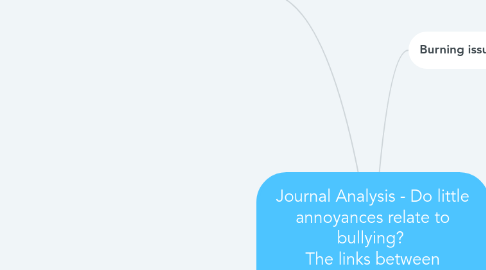Journal Analysis - Do little annoyances relate to bullying? The links between personality, attitudes towards classroom incivility, and bullying
by Dwiki Achadiyin Cendikya

1. Most related previous studies
1.1. Previous research (Spadafora, Farrell, Provenzano, Marini, &Volk, 2016) has offered the possibility that attitudes towards classroom incivility may be a potential intermediary between broader individual traits (e.g., personality) and antisocial behaviours (e.g., bullying).
1.2. Previous findings have also reported that undergraduate students with narcissistic tendencies were more likely to be perpetrators of incivility (Nordstrom, Bartels, & Bucy, 2009)
1.2.1. It is also worth noting that research examining temperamental traits has previously found differing profiles of individual differences with regard to adolescent attitudes towards intentional and unintentional incivility (Spadafora et al., 2016).
1.3. no research has been done specifically linking classroom incivility with the HEXACO Personality Inventory, a general six-factor personality model that has been demonstrated to specifically outperform other models of personality in explaining antisocial behavior (ie, Book, Visser, & Volk, 2015; Hodson, Book, Visser, Volk, Ashton, & Lee, 2018).
2. Data collection techniques/instruments
2.1. SELF-REPORT QUESTIONNAIRES. The sample comprised 396 adolescents (58.2% female) between the ages of 13–18 years. The researcher used a questionnaire because The researcher wanted to know the higher score and the latent variable. There are 3 parts. the first is School Bullying Questionnaire to create the latent variable for bullying, higher scores indicated higher bullying perpetration. the next is the Adolescent Attitudes towards Classroom In/Civility Questionnaire, higher scores indicated higher incivil attitudes. The last is the HEXACO Personality Inventory, higher scores indicated higher levels of each personality factor. The questionnaire contains 60 items that ask about the student's personality. Some of these questions include honesty, emotionality, etc. Where they choose points on a scale of 1 (strongly disagree) - 5 (strongly agree). It is called self-report because it requires students to assess themselves.
3. Data analysis techniques
3.1. This research use Quantitative data analysis with Structural Equation Modelling Is using a two-step procedure The first step was to conduct a confirmatory factor analysis to determine whether the proposed measurement model for bullying had acceptable fit. In the second step, a path analysis was conducted to test the structural model with direct and indirect paths from the HEXACO personality traits through both intentional and unintentional incivility to bullying.
4. Burning issue
4.1. The journal were specifically interested in whether attitudes towards behaviour deemed as ‘incivility’ were associated with more serious bullying behaviour. Beyond any associations with each other, the journal were also interested in whether incivil attitudes and bullying share common personality correlates among adolescents. To answer these questions, this study examined the links between HEXACO personality traits, intentional and unintentional incivility, and bullying.
5. Grand Theory
5.1. Unintentional incivility involves behaviours that lack the planning and intention to harm others and instead are thoughtless or inconsiderate (e.g., packing up books before a lesson is over). Intentional incivility involves behaviours that are planned and deliberate with the intention to harm others (e.g., talking during a lecture; Farrell et al., 2015; Marini 2009). this is the grand theory of this research because it becomes the conceptualization of intentional and unintentional incivility. besides, the researcher also said that will use this concept discussed by Farrell and colleagues (2015) for the purpose of this article.
6. Personal comment about the journal article
6.1. This journal article discusses the personality and attitude of students related to incivility and bullying that occur in a learning class. What's new I got is how they collect data. Structural equation modeling is the technique they use to collect data. That is new to me.


